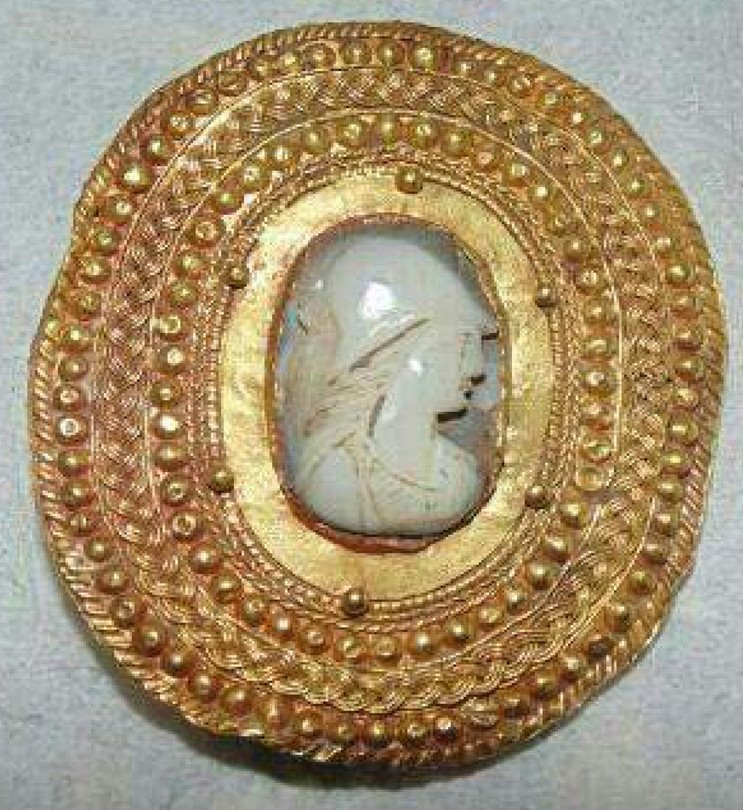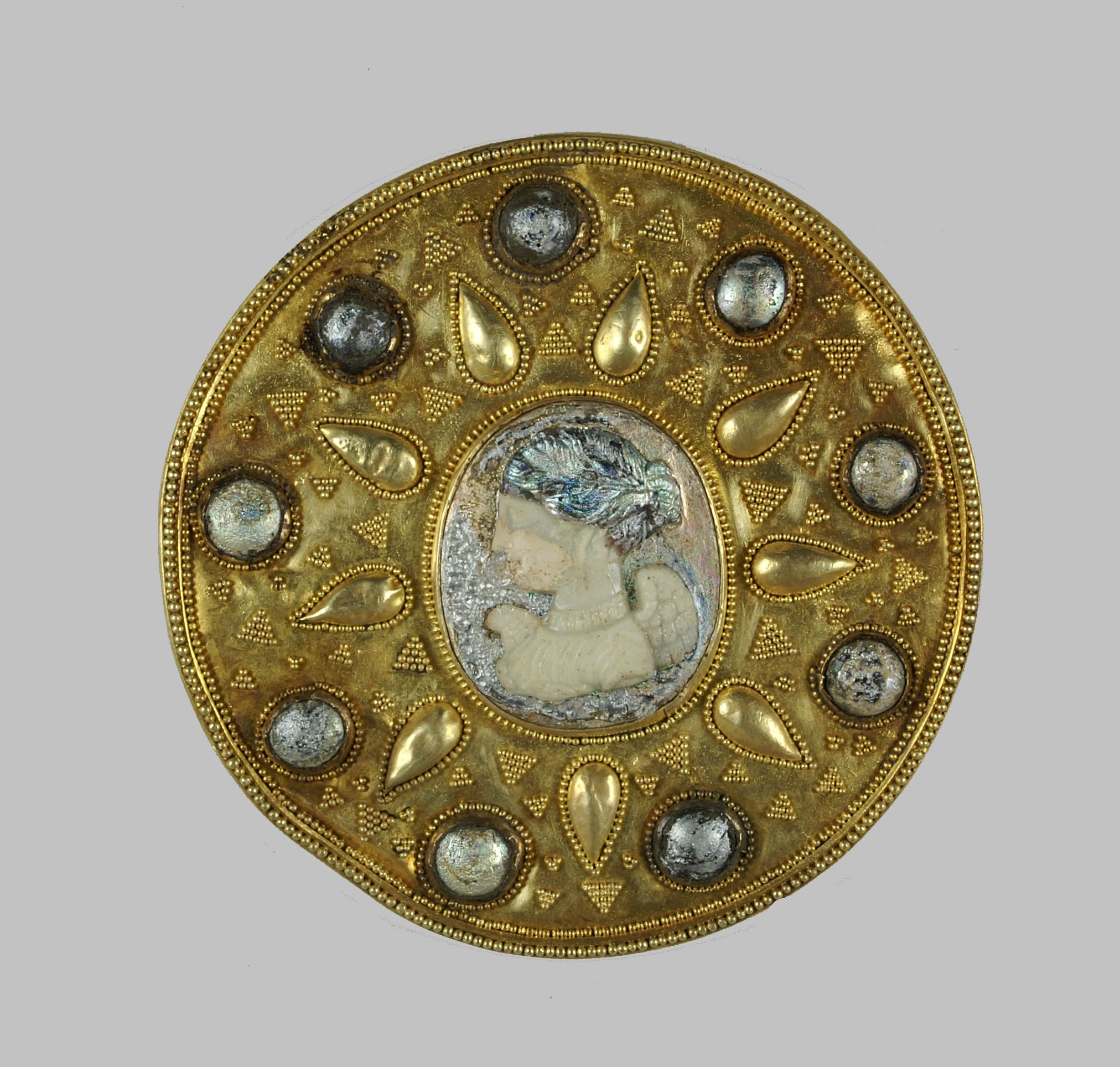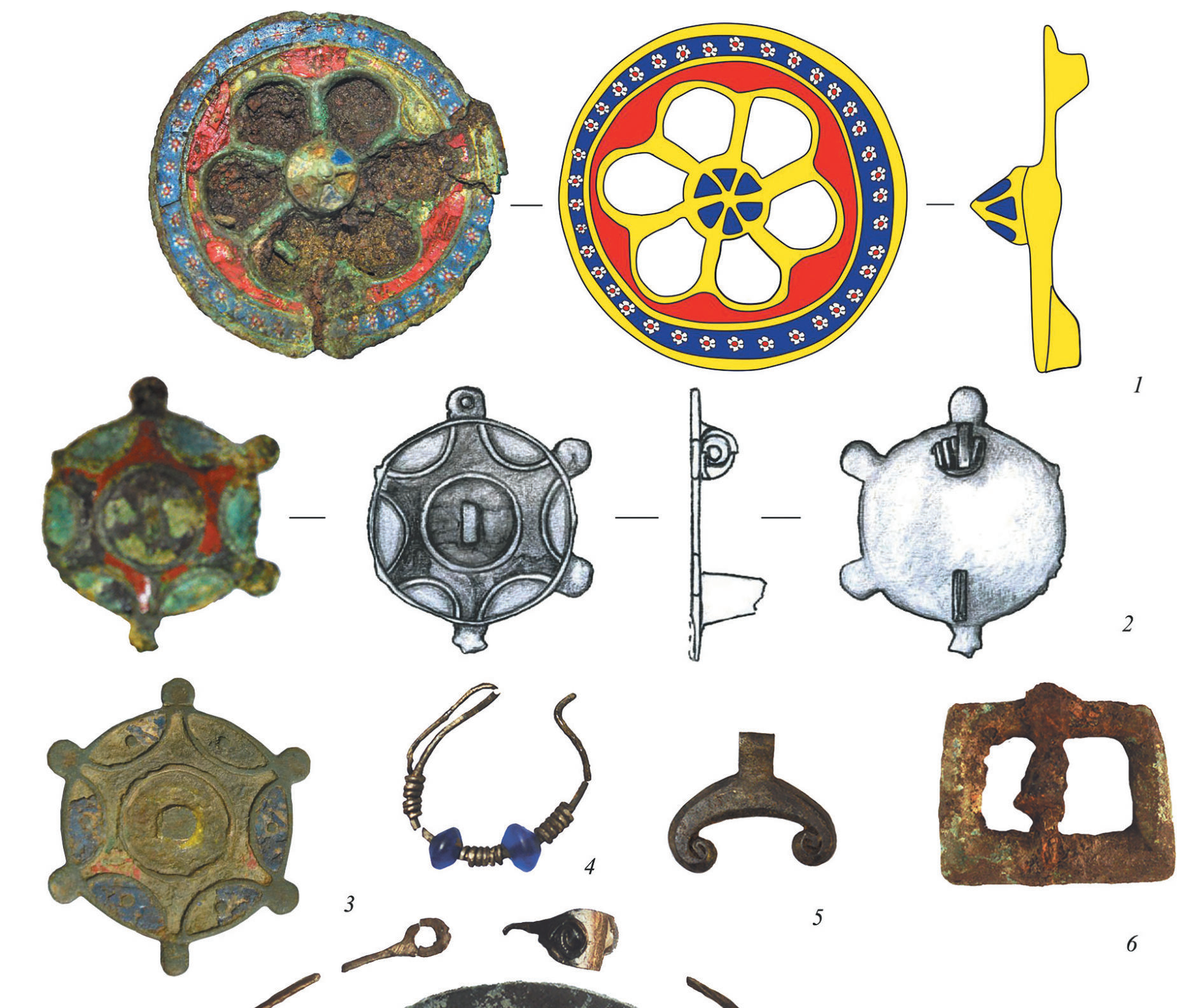Fibula-brooch from barrow 1 Psenafa (outskirts of Maikop), Republic Adygea
[Yuri Prokopenko]
3rd-2nd C BCE
Diam. disc 4.15 cm, length with pendants 16.3 cm


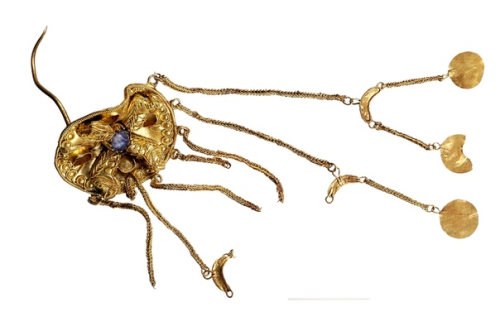
“fibula-brooch with four figurines of animals (rams or horses?) and pendants in the form of crescents and sun disks on chains, discovered in the sanctuary. A chalcedony insert has been preserved in its center, while stones from the other four castes have been lost. For the production of this product, various jewelry techniques were used – filigree, granulation, filigree. Presumably, this product goes back to the Colchis school of jewelry art and has a number of artistic parallels among the products found both in the South and North Caucasus. These are a brooch with animal figurines from Vanya, a randomly found fibula-brooch from Karachay-Cherkessia, now kept in the Stavropol Museum, and a fibula from a private collection in England, presumably originating from the Black Sea region. Fibula-brooch from Psenafa, subjected to deliberate ritual damage, can be preliminarily dated to the 3rd-2nd centuries BCE”
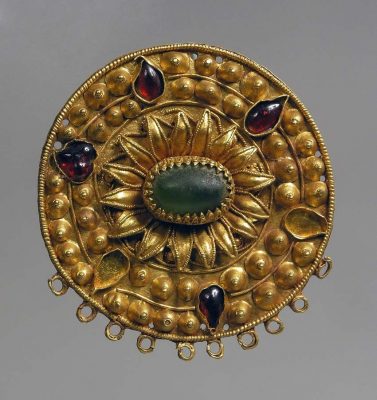
Brooch, gold, garnets, green glass paste, Nogaichik barrow, Crimea; 1st C BCE-1st C CE


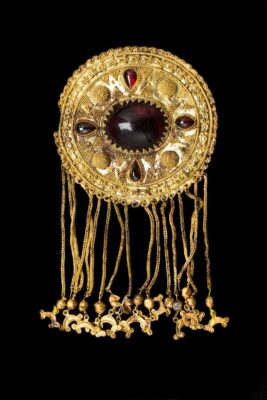
From auction
Read more >> https://colorsandstones.eu/2021/12/08/brooches-from-auction/


Thaw Collection 2012.2:13
Northeastern Black Sea, Maeotian-Sarmatian. Middle to 2nd half of 2nd century BCE
Gold, chalcedony, carnelian, 121 x 32 mm
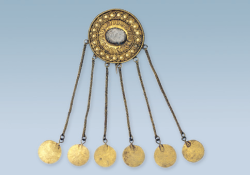
Краснодарский край, Тенгинский грунтовый могильник.
Втор. пол. II в. до н. э.золото
Инв. № 2247 М-IV
Archaeology of the Northern Caucasus
E.A. Beglova, T.A. Gabuev, I.V. Ksenofontova, L.M. Noskova
Archaeology of the Northern Caucasus
https://library.orientmuseum.ru/images/pdf/Archeologia_Sev_Kav_2014.pdf
“Objects from the Tenginsky ground burial, located on the western outskirts of the Tenginsky village in the Ust-Labinsky district of the Krasnodar Territory. The burial ground appeared in the middle of the 3rd century BCE and existed until the 3rd century CE.
Probably, a young (less than 30 years old) woman belonged to the upper strata of the Meotian society, whose burial was excavated by the expedition of the SMOA. She was buried, like the warriors-riders, in a pit with a ledge on which a bridled horse lay. The buried woman’s long-length dress was embroidered on the shoulders and along the hem with gold threads. The head was covered with a scarf, fastened with a large brooch-clip with pendants. A large gold earring lay near the head. Numerous beads from necklaces and two pendants made of antique carnelian gems were found on the chest of the deceased. On one of them there was an image of Apollo, on the other – Eros.” [https://www.orientmuseum.ru]

https://www.pba-auctions.com/

Auction description:
“PONTIC FIBULA. Rare fibula formed of a disc to which are attached chains adorned with plates. The disc, cut from gold leaf, is divided into two circular areas separated by a plain thread. In the center is a hemisphere covered with fine granulations surrounded by meshed triangles. The outer zone is adorned with six small hemispheres in alternating mesh of pairs of filigree threads in S, three of which are circled. A pearl thread covers the border. The lower edge is fitted with eight rings to which are attached braided chains ending in heart-shaped plates edged with S-shaped threads with granulations at the ends. Each plate supports two braided chains (one lacunar), each ending with a disc in thin gold leaf. Vertical pin on the back side
Pontic Steppe, second half of the 2nd century BCE
H: 12.5 cm. Weight: 40 g
British collection.
This fibula, with pendants hanging from chains and a vertical attachment on the reverse, belongs to a rare type, known exclusively from Sarmatian burials in the Kuban region, dated to the second half of the 2nd century BC. The Kurganinsk tomb and No. 177 of the Stanitsa Tenginskaya necropolis provided the closest parallels.”
Second time auctioned in 2021 by TimeLine Auctions Ltd. London, UK
“2nd-1st century BC. A substantial gold disc brooch with chains and pendants; the brooch a sheet-gold disc with beaded gold wire rim surrounding three bosses with granulated ornament and three bosses with granules each set within a beaded filigree hoop; tapering pin to the reverse; interstitial applied filigree ornament of granules and beaded filigree scrolls; beaded filigree ring surrounding triangular granule clusters, central boss with similar clusters to the lower body and granulation above; eight applied loops to the lower rim of the brooch, from each a trichinopoly chain supporting a lobed plaque with applied filigree and granules, two loops to the lower edge and from each loop a short chain with sheet-gold disc finial; mounted in a custom-made display box. Dr. Adams, N. edn., Masterpieces of Eurasian Art, London, 2008. Formerly with Pierre Bergé & Associés, Paris, Archéologie, 30 May, 2015, lot 177 (16,000 / 18,000 euros); previously in an English collection; accompanied by a ten page examination report by Dr. habil Mikhail Treister dated 14 December 2007; an independent specialist report and valuation by graduate gemmologist and jewellery expert Anna Rogers, GIA GG, BA, Gem-A, ref. no.168725/07/12/2020; copies of the relevant pages from Masterpieces of Ancient Eurasian Art where this piece is published; and a copy of the relevant Pierre Bergé & Associés catalogue pages; this lot has been checked against the Interpol Database of stolen works of art and is accompanied by AIAD certificate number no. 10352-168725.”
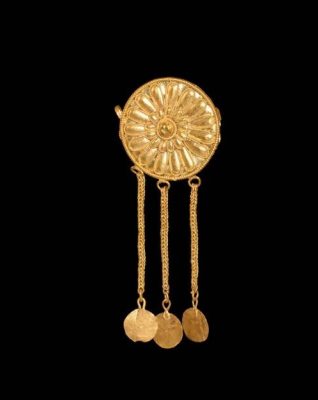
“Greek Gold Flower Brooch with Pendants. 5th-3rd century BC. A sheet gold discoid plate brooch with concentric beaded wire borders, radiating filigree petals, central cell with dome, three chains supporting discoid dangles, loop and catch to the reverse. 6.88 grams, 69mm (2 3/4”). Formerly in the private collection of an American brooch connoisseur; formed 1950s-early 1990s.[No Reserve]
Very fine condition, pin absent.”
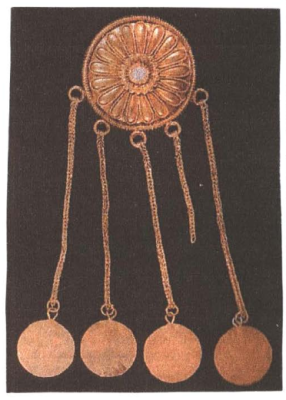
Brooch from Novo-Vochepshiy aul (фибула-брошь из аула Ново-Вочепший) [Yuri Prokopenko]
- Fibula-Brooch with Pendants from the Barrow Studied in the Northern Surrounding Areas of Cherkessk; Yuri Prokopenko
https://www.academia.edu - Ю.А. Прокопенко, С.Л. Кравцова; ФИБУЛА-БРОШЬС ПРИВЕСКАМИ ИЗ СОБРАНИЯ СТАВРОПОЛЬСКОГО ГОСУДАРСТВЕННОГО МУЗЕЯ ЗАПОВЕДНИКА https://dspace.ncfu.ru
- Vladimir Erlikh, Древности “Долины яблонь” Каталог выставки. 2014 https://www.academia.edu
- The work of the Caucasian expedition in 2012, an article by Vladimir ERLIKH [Работа Кавказской экспедиции в 2012 г., Владимир ЭРЛИХ] http://www.kavkazoved.info/news/2013/01/28/rabota-kavkazskoj-ekspedicii-v-2012-respublika-adygeja.html
- https://izverzhenie-vulkana.ru/2020/11/psenafa_kompleks_meotskoj_arheologicheskoj_kultury_najdennyj_na_okraine.html
- Art Treasures of Ancient Kuban, The catalog of an exhibition, Moscow 1987 https://iccs.synthasite.com/resources/Art%20Treasures%20of%20Ancient%20Kuban.pdf





